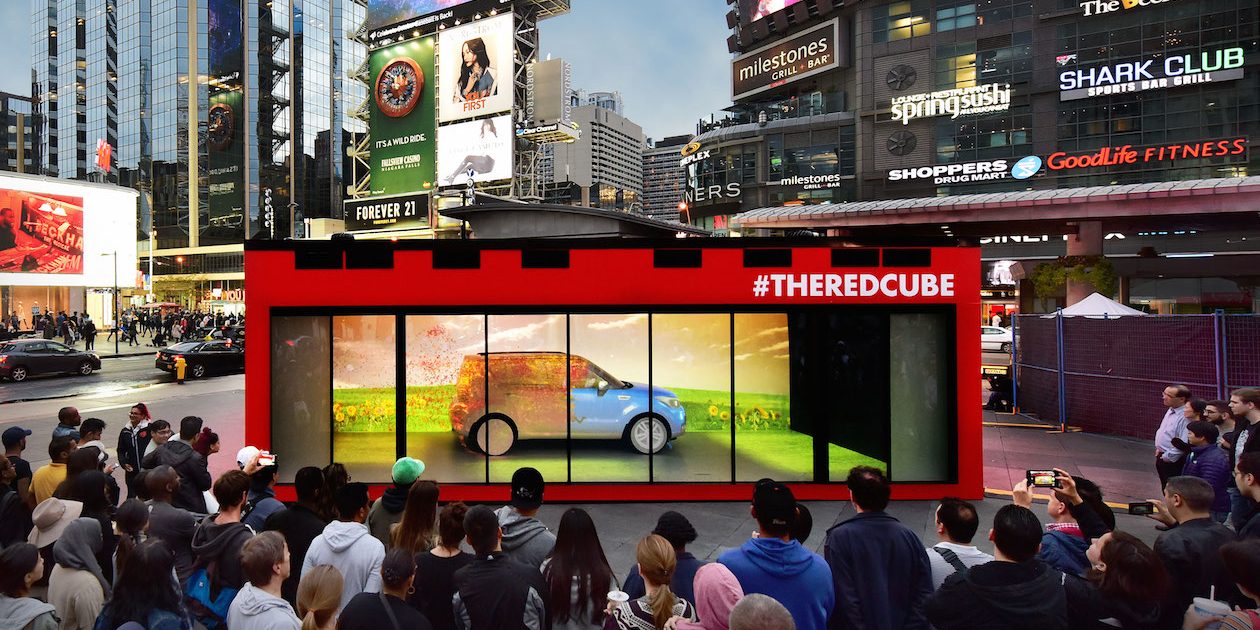Kia Canada is thinking inside the box with a new experiential marketing initiative called the Red Cube.
Developed in association with its agency of record, Innocean Worldwide Canada, the Red Cube is an unbranded 30-by-30 foot cube that uses projection mapping technology to display video on the Soul, Sportage and Forte models housed inside.
Kia used online and wild posting teaser campaigns in Vancouver, Toronto and Montreal to drive people to TheRedCube.ca (LeCubeRouge.ca) website, creating buzz about the installation prior to its appearance in high-traffic areas in the three cities.
The exterior of the Red Cube featured cryptic clues about the brand, such as “We turned clay into gold” – a reference to the clay design models used by automakers, and the subsequent awards won by Kia – and “I am constantly improving” in order to pique consumer interest.
“You might have thought that it was a high-tech company or clothing brand,” said Steve Carter, director of marketing for Kia Canada in Toronto.
When consumers stepped closer to the cube, the exterior walls become transparent, enabling them to see an unbranded vehicle inside. The projection technology then displayed back-to-back short videos about the Kia models before revealing the Kia nameplate.
Carter said the made-in-Canada marketing program embodies Kia’s tagline “The power to surprise.”
Cory Smythe, vice-president, group director, client business for Innocean, said the goal was to boost overall opinion of Kia and its vehicle line-up, while eliminating pre-conceived notions of the brand.
“Many people perceived the brand as being cheap and affordable, so they were buying the deal, not necessarily the vehicle,” said Smythe. “With all the awards and accolades that Kia has amassed over the years, it was about getting those messages out there before they even realized it was a Kia.”
Kia has sold more than 750,000 vehicles since entering the Canadian market in 1999, but is actively working to establish a new perception of the brand among Canadians.
While it skews younger than many other automotive brands, Carter said Kia also appealed to “young at heart” consumers who lead an active lifestyle. “They are very much engaged with a work hard, play hard mentality,” he said.
Carter said Canadians have traditionally equated Kia with affordable, low quality and “uninspired” designs, but the company has undergone a “product renaissance” in the past five to eight years.
The company has won both design and safety awards in recent years, and recently topped J.D. Power the 2016 U.S. Initial Quality Study, which documents problems reported by vehicle owners during the first 90 days.
It marked the first time in 27 years the award was not bestowed upon a premium brand, and the second straight year in which Kia led all non-premium makes in initial quality.
“We have [experienced] a complete turnaround and it’s the new Kia: Great design, great quality with a lot of value,” said Carter.
Carter said about 72,000 people engaged with the Red Cube for an average of five minutes in each of the three markets. He said the results were encouraging enough for Kia to pursue more of this type of marketing.
“We’re always looking for ways to engage with consumers and change their opinion of what the Kia brand is all about,” he said. “Whether that is through auto shows or other activations such as our sponsorship of the three Canadian MLS franchises, or our association with [comedy festival] Just for Laughs.”
Carter said Red Cube initiative is being supported by a “comprehensive” media plan in the final quarter that includes TV and digital, and will be used in marketing efforts throughout 2017.
Kia was established in Korea in 1944 as a manufacturer of bicycle parts, with automotive production beginning in 1973.











